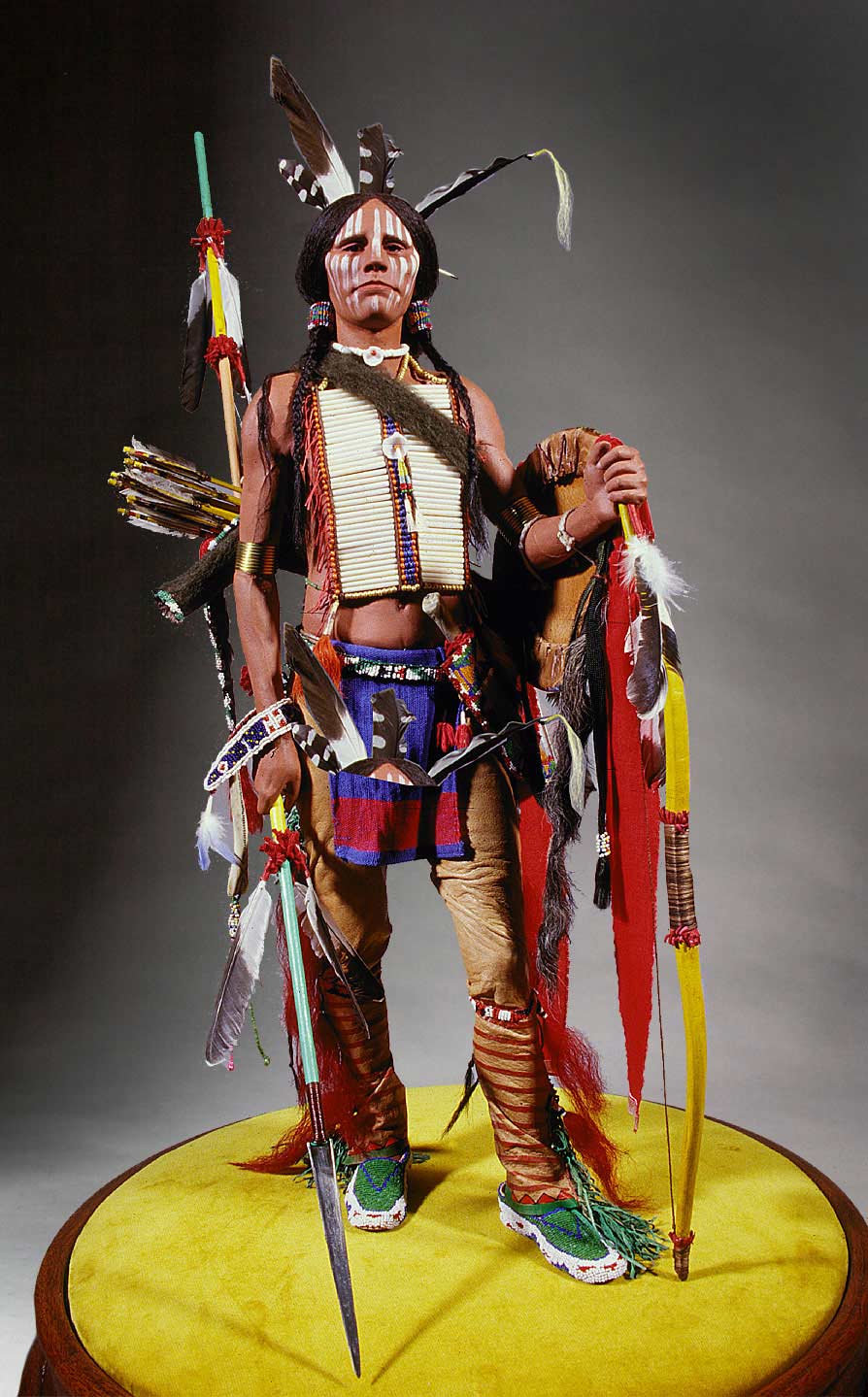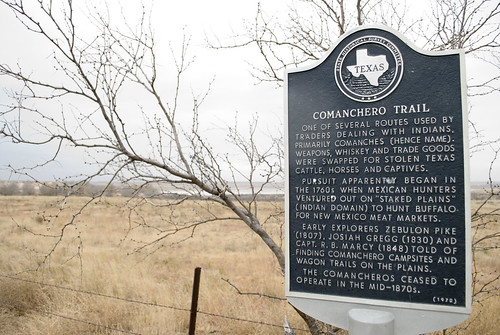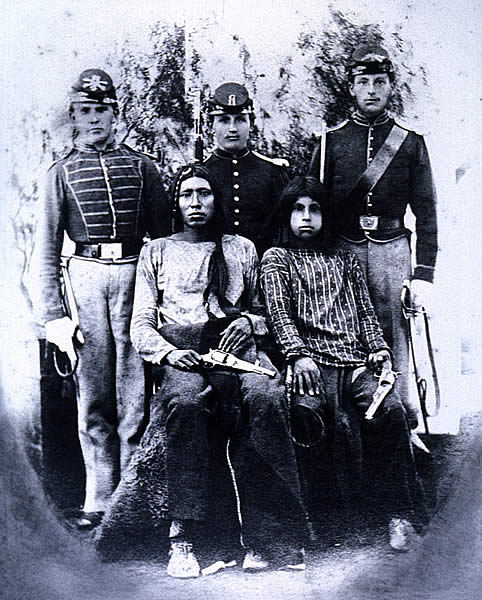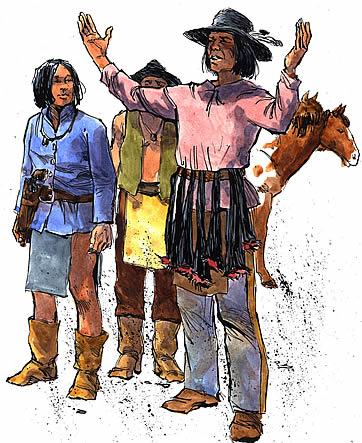and it means Indian trader in the U.S South West
The Crescent Mexicans really are crying out for you to convert them, they are the best on the market and can still be had for a few pence on e.Bay, lets look at the Mex with the sword, if we are thinking commancheros then a sword is in keeping. You'd really need to lose that Airplane pose so you could make the gun holding hand come down.But there is plenty of possibility here.
At a time when few people dared to traverse the forbidding Llano Estacado on the South Plains of Texas, a group of people known to history as the Comancheros made quite a living in a region known at the time as "Comancheria" and marked on maps as "The Great American Desert." It wasn't a desert, but hardly anyone except the Comanches and Comancheros knew this.

Generally referred to as "half-breeds" by uncomprehending Anglos, the Comancheros made a living by trading with the Comanches. They were a combination of entrepreneurs and soldiers of fortune, with a little explorer mixed in for good measure. The fact that their steadiest customers were the Comanche bands scattered across the llanos and canyonlands added an element of danger to their version of free enterprise.
 half breed traders on the missouri
half breed traders on the missouriThe Comancheros were also trailblazers, cutting paths across the plains that were later followed, fatefully for the Comanches, by the U.S. Army and early-day settlers and ranchers. The Comancheros' sales territory extended from their native New Mexico east to the Wichita Mountains of Oklahoma(below), and as far east and south as the Davis Mountains.

That turf was opened up with a 1786 treaty between Juan Baptista de Anza, the Spanish governor of New Mexico who had dramatically scored a couple of rare, but decisive, military defeats of the Comanche in Colorado.
 The treaty allowed trade between New Mexico and the Comanches in exchange for protection of the Spanish territories and thus created a market the adventurous businessmen known as Comancheros. The most amazing thing about the treaty was that both sides actually observed it.
The treaty allowed trade between New Mexico and the Comanches in exchange for protection of the Spanish territories and thus created a market the adventurous businessmen known as Comancheros. The most amazing thing about the treaty was that both sides actually observed it.
At a predetermined meeting point on the llanos or in New Mexico, the Comanches would bring cows, horses, hides and captives. This last commodity brought the scorn of governments and settlers, but was too lucrative for the Comancheros to pass up.

An announcement by U.S. Army General Zachary Taylor that the government would pay for any captives brought in to Fort Gibson (in what is now eastern Oklahoma) had an unintended result: the number of captives skyrocketed and the market for them boomed. For the Comancheros, it was a lucrative niche market where they operated as the middle man.

Established in 1824 by Colonel Matthew Arbuckle on the east bank of the Grand River just above its confluence with the Verdigris and Arkansas Rivers, the fort was responsible for keeping peace between the Osage, who opposed any intrusion into their territory, and the Cherokee, who were already filtering into Indian Territory.

The practice earned the Comancheros a reputation among Anglos that can be clearly seen in Josiah Gregg's description of the traders: "These parties of Comancheros are usually composed of the indigent and rude classes of the frontier villages, who collect together several times a year, and launch upon the plains with a few trinkets and trumperies of all kind, and perhaps a bag of bread or pinole."
Sometimes the Comancheros merchandise included the latest fashions from Europe, which the Comanches seemed to appreciate. In his book "Caprock Canyonlands" Dan Flores wrote of Comanche chief Ysamabani (Handsome Wolf) and his band of dandies: "Francisco Amangual found him in the Yellow House in 1808, leading a band of marvelously fashion-conscious Comanches decked out in the latest in three-cornered hats, long red coats with blue collars, cuffs and white buttons, the effect set off with red neckties."
In time, the trade came to include guns, ammunition and whiskey and more than a few head of stolen cattle and horses. The Comancheros sold these to wily merchants who often sold the livestock back to the original owners.

The beginning of the end for the Comancheros came when Colonel Ranald Mackenzie, with orders to exterminate the last band of wild Comanches (or any other tribe for that matter) found an old Comanchero trail that ran from present-day Tucumcari, NM to what is now Canyon, Texas on the edge of the Palo Duro. The trail was told to Mackenzie by a captured Comanchero, Polonio Ortiz, who was promptly transcripted into service by Mackenzie as a scout.

The Comanches held out longer and more fiercely than any tribe in American history, but once the Red River War was concluded and Quanah Parker and his warriors had surrendered, the Comancheros had no customers and no more captives. They faded into history, usually as a footnote to some larger story.

Many of the old Comanchero trails and the ones credited to Mackenzie and his soldiers are still in existence, though there is virtually no trace of the old Comanchero culture to be found anywhere. The trails now are generally paved and are marked on maps as U.S. and State Highways and County Roads. Aside from a colorful chapter of history, these roads are the bulk of what the Comancheros left to mark their existence and survival in a harsh land during violent times.
Especially in the 19th centuryThe Texas–Indian Wars were a series of conflicts between settlers in Texas and Plains Indians.

These conflicts began when the first settlers moved into Spanish Texas, and continued through Texas's time as part of Mexico, as its own nation, Republic of Texas, and did not end until 30 years after Texas joined the United States.
The conflicts went on from 1820, until 1875, when the last free band of Plains Indians, the Comanches led by Quahadi warrior Quanah Parker, surrendered and moved to the Fort Sill reservation in Oklahoma.
The half-century struggle between the Plains Tribes and the Texans became particularly intense after the Spanish, and then Mexicans, left power in Texas, and the Republic of Texas, and then the United States, opposed the Tribes. Their war with the Plains Indians became one of deep animosity, slaughter, and, in the end, near-total conquest.

Although the outcome was lop-sided, the violence of the wars were not. When he recovered Cynthia Ann Parker at Pease River, Sul Ross observed that her recovery would be felt in every family in Texas, as every one of them had lost someone in the Indian Wars.
Indeed, during the American Civil War, when the army was unavailable to protect the frontier, the Comanche and Kiowa pushed white settlements back over 100 miles on the Texas frontier
In the 1820s, seeking additional settlers as a means of stabilizing the area, Mexico reached an agreement with Stephen F. Austin reauthorizing his Spanish land grants. That allowed several hundred Anglo families to move into the region. As word spread of rich lands in Texas, thousands of additional settlers from the United States flooded into Texas, many of whom were not interested in being ruled by the government of Mexico.

In 1829, when Mexico abolished slavery throughout Mexico, the immigrants from the U.S. were exempted in some colonies or actively evaded governmental efforts to enforce the national abolition of slavery in the territory. Theoretically, many slaves in Mexico at this time were indentured servants. This was coupled with complaints about the tightening political and economic control over the territory by the central government in Mexico City, leading to the Texas Revolution .
In 1821, while settlers were still welcome, Jose Francisco Ruiz negotiated a truce with the Penatucka Comanche, the band closest to the settlements in East and Central Texas.

Following that truce, he was able to finalize a treaty of peace and friendship, which was signed in Mexico City in December 1821. Within twelve months the Mexican Government failed to pay the presents promised the Pentucka, who resumed raiding at once. For the same reason, failure to pay promised tributes, the peace treaties signed for New Mexico broke down, and by 1823 war raged the entire length of the Rio Grande.[
 toknowa indians
toknowa indiansAdditional treaties were signed in 1826 and 1834, but in each case the Mexican government failed to meet the terms of the agreement. Comanche raiding parties found particularly easy prey in the new Anglo settlers in Texas, despite the Mexican government’s reauthorization of the bounty for Indian scalps in 1835.
 toknawa
toknawaBeing used to the more subjugated tribes in the eastern United States, Texan settlers were unprepared for the military power of the Comanche and Kiowa. The raids on the settlers were so severe that echos of the cries were heard in Washington, which attempted to interfere to protect American settlers in Texas.
When Sam Houston arrived in Texas in 1833 as a United States diplomatic representative to arrange a treaty with the Pentucka Comanche, outraged Mexican officials objected to an American diplomat in their country talking to their natives about a treaty. Houston was declared persona non grata and asked to leave the country.

During the entire period of 1821 to 1835, settlers had difficulty with Comanche raids, despite the formation of the Texas Rangers in 1823. Tonkawa and Delaware Indians, deadly enemies of the Comanche, had declared themselves friends of the settlers, attempting to gain allies against their traditional enemies.
The Comanche truly detested the Tonkawa in particular, for being cannibals, which the Comanche regarded with horror. There is no record of Europeans criticising the Tonkawa cannibalism as long as the Tonkawa stuck to eating Comanches instead of settlers.

Stephen F. Austin had recognized the need as early as 1823 to have specific forces ready to fight the Plains Tribes, especially the Comanche, who made no distinction between Hispanic and Anglo victims in their raids.

Austin created the first Rangers by hiring 10 men who were paid to fight Indians and protect the frontier settlements. Soon the settlers were organizing other Ranger companies. After the Republic was created, this trend continued – without resources for a standing army, Texas created small ranger companies mounted on fast horses to pursue and fight Comanches


No comments:
Post a Comment